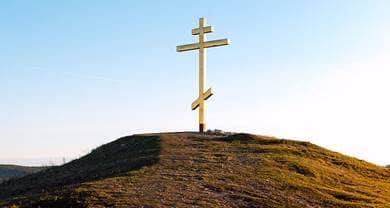- Trending:
- Pope Leo Xiv
- |
- Israel
- |
- Trump
- |
- Social Justice
- |
- Peace
- |
- Love

RELIGION LIBRARY
Eastern Orthodoxy
Exploration and Conquest
In the 7th century, shortly after the death of Muhammad, Arab armies began to conquer territories bordering the Arabian peninsula. They quickly conquered Syria and Egypt, assisted by Christians and Jews within those territories who had been persecuted by Byzantine emperors since the time of Emperor Justinian (c. 483-565). The Muslim caliphs had set their sights on the conquest of all the territories of Byzantine Empire, and in 670 attacked Constantinople from the sea. This attack failing, they tried again in 717, this time in a combined land and sea operation that also failed. In the 9th century, the Byzantines gained the upper hand and retook most of Syria, again ruling an empire that extended from Greece to Arabia. But in 1071, the Seljuk Turks defeated the Byzantine army in the battle of Manzikert, and quickly thereafter took all of the eastern Byzantine territories.
The Byzantines turned to Europe for help, and the Europeans complied, at least in part because they too had designs on the territories of the Byzantine Empire. The Crusaders pushed the Turks back and returned territory to the Byzantines, but they also set up kingdoms of their own in Syria and Palestine. In 1204, the Crusaders attacked Constantinople, pillaging the city and expelling the Byzantine government and its Christian leadership. The Byzantines retreated to Greece, and in 1261 they retook Constantinople. But the damage was done, and the Byzantine Empire was no longer anything more than a small kingdom centered in Constantinople. In 1453, the city was permanently conquered by the Ottoman Turks, and renamed Istanbul. The focus of Eastern Orthodoxy shifted north, to the Russian Tsar, who became the new protector of the faith. The Russian Orthodox Church became autocephalous, or self-governing, in 1589, the metropolitan of Moscow elevated to the status of patriarch.
The rest of the Orthodox world, from Greece to Romania and most of the Slavic territories except for Russia, was ruled by the Ottoman Turks from the 15th to the early 19th centuries. The Muslim Ottomans regarded the Orthodox Christians as second-class citizens. The Christian religion was tolerated, but not encouraged, and the speculative life of the church stagnated with few opportunities for studying or publication. The ecumenical patriarch of Constantinople was invested by the Ottoman authorities with both civil and religious responsibilities for all Orthodox in the Ottoman Empire, and the patriarchate by necessity took a defensive stance, striving to preserve tradition, a policy that effectively squelched innovation.
During this period Orthodox Christians increasingly engaged with western Christians and western Christian thought, as Orthodox Christians desiring to study and write enrolled in western seminaries and universities. In addition, both Roman Catholic and Reformation Christians turned to the Orthodox, seeking allies in the controversies over the Reformation. Orthodox scholars and clergy tended to remain neutral, but nevertheless their exposure to Reformation debates led to fresh engagement of their own on questions of scripture, sacrament, the fate of the eternal soul, and the role and duties of the church in the world. Engagement with such concepts as predestination, purgatory, infallibility, and transubstantiation appeared in the writings of Orthodox patriarchs and bishops through the 18th century, but these ideas did not make their way into Orthodox doctrine. By the early 20th century, Orthodox scholars in Russian and Greek theological circles began turning to the Church Fathers for inspiration in articulating the unique characteristics of Orthodox faith and practice.
The Ottoman Empire began crumbling in the early 19th century. Orthodox subjects liberated from Turkish rule in the 19th century include Greece (1833), Romania (1864), Bulgaria (1871), Serbia (1879), and Albania (1937). As these nations emerged from Turkish rule, the role of the ecumenical patriarch of Constantinople diminished in favor of national churches. The churches of these countries became autocephalous, or autonomous and self-governing, although the ecumenical patriarch was still regarded as "first among equals." The autocephalous churches in Russia and the former Ottoman territories became state churches, closely allied with nationalist sensibilities and funded by the government.
At the start of the 20th century, two historic events occurred that were to have far-reaching consequences for Eastern Orthodoxy. Russia underwent the Bolshevik Revolution in 1917, and the Communist ideology was strongly anti-religious. In 1922, the Greek armies were defeated in the Greco-Turkish war, which led to the establishment of the Republic of Turkey. Under the provisions of the Treaty of Lausanne, Greece and Turkey engaged in an exchange of populations in 1923. Both of these events hastened the emigration of Orthodox Christians to the west, a phenomenon that had already gathered momentum prior to World War I.
The transfer of Christian populations from Turkey to Greece reduced the size of the church in Istanbul, the historical ecumenical patriarchate of Constantinople, to a few thousand. The ecumenical patriarch's congregations are now concentrated in Crete, western Europe, Australia, and North America. In Greece, the historic alliance between church and state weakened, especially in the latter part of the 20th century. By 1982, the authorities were allowing civil marriages as an alternative to marriage in the church. However, in Greek Cyprus, the relation between church and state seems as strong as ever.
In Russia, the militantly anti-religious stance of the Bolsheviks had serious consequences for the church. Land and properties were seized and most churches, monasteries, and church schools were closed. During the 1920s and 1930s, unknown numbers of Christians were executed, or died in prison. It is often said that more Christians died under Russian persecution than died under Roman persecution in the first few centuries of the second millennium. Christians were forced to worship in secret, and hide their faith from family members. Persecution was relaxed in 1943, when Stalin realized that Orthodoxy would assist in the war effort, but accelerated again after 1960. In the Soviet republics of eastern Europe after World War II, the anti-religious Communist regimes in Serbia, Romania, Bulgaria, Poland, the former Czechoslovakia, and Albania also repressed the churches. In Albania, the government effectively erased all visible traces of the church's existence. The fall of the Soviet Union in 1991 led to a reemergence of the Orthodox Churches in these countries.
Study Questions:
1. How have politics changed the demographics of Eastern Orthodoxy’s followers?
2. What can be said about the division of church and state within Eastern Orthodoxy’s contemporary history?
3. How was Eastern Orthodoxy persecuted within the 20th century?










